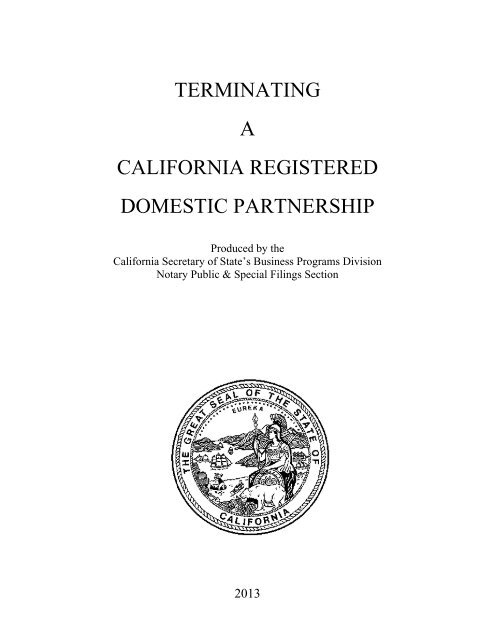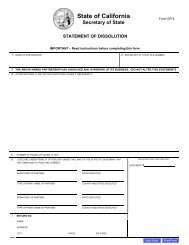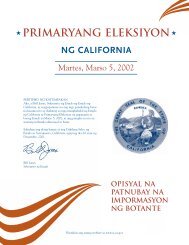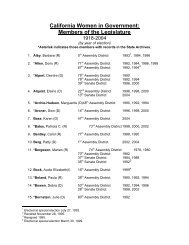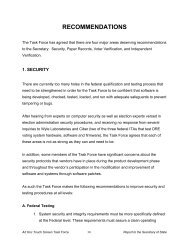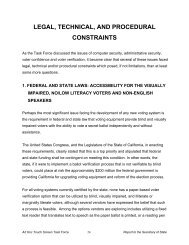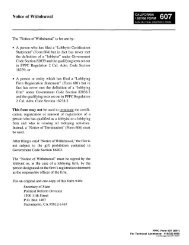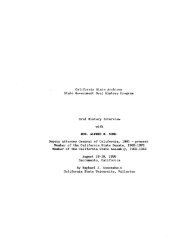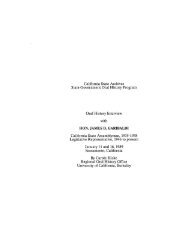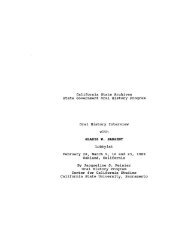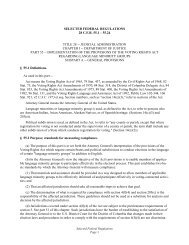terminating a california registered domestic partnership
terminating a california registered domestic partnership
terminating a california registered domestic partnership
Create successful ePaper yourself
Turn your PDF publications into a flip-book with our unique Google optimized e-Paper software.
TERMINATING<br />
A<br />
CALIFORNIA REGISTERED<br />
DOMESTIC PARTNERSHIP<br />
Produced by the<br />
California Secretary of State’s Business Programs Division<br />
Notary Public & Special Filings Section<br />
2013
Table of Contents<br />
What is this Brochure………………………………………………............................................1<br />
Some Important Terms To Know..................................................................................................1<br />
Terminating a Domestic Partnership by a Notice of Termination of Domestic Partnership........3<br />
Requirements for Filing a Notice of Termination with the California Secretary of State........3<br />
What You Should Know About Revoking the Filing of a Notice of Termination...................4<br />
An Important Difference Between Filing a Notice of Termination with the California<br />
Secretary of State and a Petition of Dissolution with the Superior Court.................................5<br />
Court Set-Aside of California Secretary of State Termination.................................................5<br />
Dissolution or Nullity of Domestic Partnership by Petition of the Superior Court......................6<br />
Petition for Dissolution of Domestic Partnership .....................................................................6<br />
Petition for Dissolution of Domestic Partnership and Marriage...............................................6<br />
Petition for Judgment of Nullity of Domestic Partnership .......................................................7<br />
Petition for Legal Separation of Domestic Partners..................................................................7<br />
Should You Consult an Attorney? ................................................................................................8<br />
Notice of Termination of Domestic Partnership….…………………………...………..Attached<br />
Revised February 12, 2013<br />
i
What is this Brochure<br />
This brochure describes the requirements for <strong>terminating</strong> a California <strong>registered</strong> <strong>domestic</strong> <strong>partnership</strong> in the<br />
State of California and explains the nature and effect of termination. In certain circumstances, if all the<br />
requirements are met, partners may terminate a <strong>registered</strong> <strong>domestic</strong> <strong>partnership</strong> by preparing and filing a Notice<br />
of Termination of Domestic Partnership form with the California Secretary of State. In all other circumstances,<br />
at least one of the partners must file a petition with, and obtain a judgment from, a California Superior Court in<br />
the same way that marriages are terminated.<br />
To terminate a <strong>domestic</strong> <strong>partnership</strong> using the procedure through the California Secretary of State, you must<br />
sign a form stating that you have read and understood this brochure. Therefore, it is important to read this entire<br />
brochure carefully. This brochure cannot answer every question that may arise in a particular set of<br />
circumstances, and this brochure is not intended to provide legal advice. For additional questions about<br />
<strong>terminating</strong> a <strong>registered</strong> <strong>domestic</strong> <strong>partnership</strong> and the effect of termination after you review this brochure, a<br />
private attorney should be consulted.<br />
If filing a Notice of Termination of Domestic Partnership, this brochure should be saved for at least six months<br />
from the date the termination form is filed with the California Secretary of State. Either partner can revoke the<br />
termination within six months of filing the termination form with the California Secretary of State.<br />
Some Important Terms to Know<br />
In order to understand the nature and effect of <strong>terminating</strong> a <strong>registered</strong> <strong>domestic</strong> <strong>partnership</strong>, the following<br />
explains some key terms that are used throughout this brochure. Additionally, both partners should understand<br />
that as a couple in a <strong>registered</strong> <strong>domestic</strong> <strong>partnership</strong>, there are certain things that the partners own together and<br />
there may be certain debts that the partners owe together.<br />
Termination of a Domestic Partnership<br />
The termination of a <strong>registered</strong> <strong>domestic</strong> <strong>partnership</strong> ends the <strong>registered</strong> <strong>domestic</strong> <strong>partnership</strong><br />
and returns the partners to the status of un-partnered persons. The partners no longer will have<br />
the rights, protections and benefits or obligations and responsibilities under the law as <strong>registered</strong><br />
<strong>domestic</strong> partners. The process of termination usually will divide all the community property<br />
and community obligations of the partners. Once effective, the termination may not be undone<br />
except in limited circumstances by order of a California Superior Court. Termination of a<br />
<strong>domestic</strong> <strong>partnership</strong> does not dissolve a marriage.<br />
Date of Separation<br />
The date of separation is the date one of the partners tells the other partner that they want to<br />
terminate the <strong>domestic</strong> <strong>partnership</strong> and there is no chance of continuing the <strong>partnership</strong>. In most<br />
cases, it is the date the partners stop living together as a couple, but if there are questions about<br />
the separation date, an attorney should be consulted.<br />
Community Property<br />
Community property is everything that the partners have acquired together after registering their<br />
<strong>domestic</strong> <strong>partnership</strong>. In most cases, that includes anything that either partner earned and<br />
anything that either partner bought with those earnings after the date the <strong>domestic</strong> <strong>partnership</strong><br />
was <strong>registered</strong> but before the date of separation. This may not be the case if a written property<br />
settlement agreement was made between the partners regarding rights to <strong>partnership</strong> property. In<br />
Revised February 12, 2013 1
that situation an attorney should be consulted regarding the partners’ respective rights to<br />
community property.<br />
Separate Property<br />
Separate property generally is everything that partners owned prior to registering their <strong>domestic</strong><br />
<strong>partnership</strong> and any interest or other income received from that separate property after<br />
registering the <strong>domestic</strong> <strong>partnership</strong> and before the separation date. In most cases, anything<br />
earned or received after the date of separation and anything received by gift or inheritance at any<br />
time is also separate property.<br />
Fair Market Value<br />
Except for bank accounts and cash, which are valued at their actual dollar amount, the value of<br />
community property is determined by adding together the fair market value of possessions that<br />
are community property. Fair market value is an estimate of the amount of money that could be<br />
obtained if those items were sold to a stranger at a flea market, garage sale, on the Internet or in<br />
the newspaper. It does not mean what was paid for those items originally or how much it would<br />
cost to replace those items now. One way of estimating the fair market value is to see what<br />
similar items are advertised for in the newspaper want ads or online auction companies. The<br />
same method is used to determine the value of separate property.<br />
Community Obligations<br />
Community obligations are the debts that the partners incurred after registering the <strong>domestic</strong><br />
<strong>partnership</strong> and before the separation date. In most cases, this includes anything still owed on<br />
any debts either of you took on after the date you <strong>registered</strong> as <strong>domestic</strong> partners but before the<br />
date of separation. A debt is usually still a community obligation even when only one partner’s<br />
name is on the loan.<br />
Property Settlement Agreement<br />
A property settlement agreement is an agreement in writing, signed by both partners, explaining<br />
how community property will be divided upon termination of the <strong>domestic</strong> <strong>partnership</strong> and how<br />
much each partner will pay on the community obligations.<br />
Petition for Dissolution of Domestic Partnership<br />
A Petition for Dissolution of Domestic Partnership is the formal request by one partner to a<br />
California Superior Court for the court to dissolve the <strong>domestic</strong> <strong>partnership</strong>. It is similar to a<br />
Petition for Dissolution of Marriage (a divorce), but it does not dissolve a marriage. See below if<br />
the partners also are married to one another and want to dissolve the marriage.<br />
Petition for Dissolution of Domestic Partnership and Marriage<br />
A Petition for Dissolution of Domestic Partnership and Marriage is the formal request by one<br />
partner/spouse to a California Superior Court for the court to dissolve both the <strong>domestic</strong><br />
<strong>partnership</strong> and the marriage during the same proceeding.<br />
Petition for Judgment of Nullity of Domestic Partnership<br />
A Petition for Judgment of Nullity of Domestic Partnership is the formal request by one partner<br />
to a California Superior Court for the court to make a determination that the <strong>domestic</strong> <strong>partnership</strong><br />
Revised February 12, 2013 2
is legally invalid (void), similar to a Petition for Judgment of Nullity of Marriage (an<br />
annulment).<br />
Petition for Legal Separation of Domestic Partners<br />
A Petition for Legal Separation of Domestic Partners is the formal request by one partner to a<br />
California Superior Court for the court to divide the community property and debts between the<br />
partners and to make other orders regarding custody of children and financial support without<br />
<strong>terminating</strong> the <strong>domestic</strong> <strong>partnership</strong>, similar to a petition for legal separation in a marriage.<br />
Notice of Termination of Domestic Partnership<br />
The Notice of Termination of Domestic Partnership is a form obtained from the California<br />
Secretary of State, which may be filed with the California Secretary of State in certain limited<br />
circumstances to terminate a <strong>domestic</strong> <strong>partnership</strong>. It only can be used when the <strong>domestic</strong><br />
<strong>partnership</strong> meets certain legal requirements.<br />
Notice of Revocation of the Termination of Domestic Partnership<br />
The Notice of Revocation of the Termination of Domestic Partnership is a form obtained from<br />
the California Secretary of State, which may be filed with the California Secretary of State by<br />
either partner within six months of filing the Notice of Termination of Domestic Partnership to<br />
stop a Notice of Termination of Domestic Partnership from <strong>terminating</strong> the <strong>domestic</strong> <strong>partnership</strong>.<br />
Terminating a Domestic Partnership by a Notice of Termination of Domestic Partnership<br />
In some specific circumstances, a <strong>registered</strong> <strong>domestic</strong> <strong>partnership</strong> may be terminated by filing a Notice of<br />
Termination of Domestic Partnership with the California Secretary of State. This is easier and more economical<br />
than <strong>terminating</strong> a <strong>domestic</strong> <strong>partnership</strong> with the Superior Court, but not every <strong>domestic</strong> <strong>partnership</strong> is eligible<br />
to file with the California Secretary of State. A <strong>domestic</strong> <strong>partnership</strong> may be terminated through the California<br />
Secretary of State only if ALL of the requirements listed below are true at the time the Notice of Termination of<br />
Domestic Partnership is submitted to the California Secretary of State for filing. Even if only one of the<br />
statements is not true, the <strong>domestic</strong> <strong>partnership</strong> cannot be terminated with the California Secretary of State and a<br />
petition with a California Superior Court to dissolve the <strong>domestic</strong> <strong>partnership</strong> must be filed.<br />
Requirements for Filing a Notice of Termination with the California Secretary of State<br />
1. We have both read this brochure and understand it.<br />
2. We both want to terminate the <strong>domestic</strong> <strong>partnership</strong>.<br />
3. We have not been <strong>registered</strong> as <strong>domestic</strong> partners more than 5 years.<br />
4. No children were born to us before or during the <strong>domestic</strong> <strong>partnership</strong>.<br />
5. We did not adopt any children during the <strong>domestic</strong> <strong>partnership</strong>.<br />
6. Neither of us is now pregnant.<br />
7. Neither of us owns any part of land or buildings.<br />
Revised February 12, 2013 3
8. Neither of us is renting any land or buildings (except where one or both of us lives, and that<br />
lease does not include a purchase option and will end within one year of filing the Notice of<br />
Termination of Domestic Partnership form).<br />
9. Not counting automobile loans, our community obligations are not more than $6,000.<br />
10. Not counting loans and automobiles, our community property is worth less than $40,000.<br />
11. Not counting loans and automobiles, neither one of us has separate property totaling more than<br />
$40,000.<br />
12. We have prepared and signed a property settlement agreement prior to submitting the Notice of<br />
Termination of Domestic Partnership form that states how community property possessions<br />
and community obligations will be divided (OR that states that no community property or<br />
community debt have been accumulated).<br />
13. We agree that we do not want money or support from the other partner except what is included<br />
in the property settlement agreement dividing the community property and community<br />
obligations.<br />
If statements 1 through 13 above are all true, your <strong>domestic</strong> <strong>partnership</strong> may be terminated by filing a Notice of<br />
Termination of Domestic Partnership with the California Secretary of State. The Notice of Termination of<br />
Domestic Partnership may be obtained from either the California Secretary of State office or from our website<br />
at www.sos.ca.gov/dpregistry/.<br />
The Notice of Termination of Domestic Partnership must be signed by both partners and filed with the<br />
California Secretary of State. Before completing the form, please review the requirements and this brochure<br />
very carefully.<br />
It is possible for a court to set aside and cancel a termination made through the California Secretary of State if it<br />
can be shown that all the requirements were not met at the time the form was filed. Although not required, it<br />
may be in your best interest prior to filing a Notice of Termination of Domestic Partnership with the California<br />
Secretary of State to see an attorney about ending your <strong>domestic</strong> <strong>partnership</strong>.<br />
How Long Does it Take to Terminate the Domestic Partnership?<br />
The <strong>domestic</strong> <strong>partnership</strong> will automatically terminate six months after the date the Notice of Termination<br />
of Domestic Partnership is filed with the California Secretary of State, as long as neither partner revokes<br />
(cancels) the termination before the end of the six-month period.<br />
What You Should Know About Revoking the Filing of a Notice of Termination<br />
Either partner can revoke (cancel) the filing of a Notice of Termination of Domestic Partnership, for any<br />
reason, at any time before the end of the six-month period that starts when the notice is filed with the<br />
California Secretary of State. The most common reasons to revoke the termination are because you<br />
decided to return to your partner and not terminate the <strong>domestic</strong> <strong>partnership</strong>; or because you decided to go<br />
to court to dissolve the <strong>domestic</strong> <strong>partnership</strong>; or because one of you is now pregnant.<br />
In order to revoke the filing of the notice of termination, a Notice of Revocation of Termination of<br />
Domestic Partnership must be filed with the California Secretary of State and a copy must be sent to your<br />
partner by first-class mail. If you decide to revoke the filing of the notice of termination, you must do this<br />
Revised February 12, 2013 4
efore the end of the six-month period or the <strong>domestic</strong> <strong>partnership</strong> will automatically terminate. The<br />
Notice of Revocation of Termination of Domestic Partnership may be obtained from either the California<br />
Secretary of State office or from our website at www.sos.ca.gov/dpregistry/.<br />
The revocation of the filing of the notice of termination cannot be canceled or undone. If you change your<br />
mind and decide to continue with <strong>terminating</strong> the <strong>domestic</strong> <strong>partnership</strong>, you will have to start the process<br />
over again (including the six-month period) by filing another Notice of Termination of Domestic<br />
Partnership with the California Secretary of State or file a petition of dissolution with a California Superior<br />
Court.<br />
An Important Difference Between Filing a Notice of Termination with the California Secretary<br />
of State and a Petition of Dissolution with the Superior Court<br />
When dissolving a <strong>domestic</strong> <strong>partnership</strong> with a California Superior Court, you have a right to a court<br />
hearing in front of a judge. If either partner is not satisfied with the judge’s decision, it is possible to<br />
challenge that decision. This can be done, for example by asking for a new hearing, or by appealing the<br />
decision to a higher court. With filing a Notice of Termination of Domestic Partnership, there is no hearing.<br />
Couples who choose to file a Notice of Termination of Domestic Partnership form with the California<br />
Secretary of State do not have the right to ask for a hearing or the right to appeal the decision to a higher<br />
court.<br />
Court Set-Aside of California Secretary of State Termination<br />
There are some cases in which a <strong>domestic</strong> <strong>partnership</strong> that has been terminated through the California<br />
Secretary of State can be challenged in court and set aside (reversed) after the six-month waiting period is<br />
over. If you believe your termination should be set-aside after the six-month period, you should<br />
consult an attorney about this possibility. The court may have the power to set aside the termination if<br />
you can show:<br />
(1) the <strong>domestic</strong> <strong>partnership</strong> did not meet all 13 of the requirements listed above at the time the Notice<br />
of Termination of Domestic Partnership form was filed, OR<br />
(2) you were deceived in agreeing to the terms of the property settlement agreement. This is possible if<br />
you find out that your <strong>domestic</strong> partner lied about the value of property to get you to agree to the terms<br />
of the property settlement agreement (e.g. certain items going to your partner turned out to be much<br />
more valuable than you thought when you filed or certain items going to you were much less valuable<br />
than you thought when you filed), OR<br />
(3) you signed the Notice of Termination of Domestic Partnership against your will. This is possible if<br />
you can show that your <strong>domestic</strong> partner used threats or other kinds of unfair pressure to get you to go<br />
along with the property settlement agreement or the termination, OR<br />
(4) there are serious mistakes in the property settlement agreement. Various kinds of other mistakes<br />
may make the termination invalid, but you will have to go to court to prove the mistakes.<br />
An attorney should be consulted for more information about a court proceeding setting aside a termination.<br />
Correcting mistakes and unfairness in a termination obtained by filing a Notice of Termination of Domestic<br />
Partnership can be difficult, expensive, and time consuming. It is very important for both partners to be<br />
honest, cooperative, and careful when <strong>terminating</strong> the <strong>domestic</strong> <strong>partnership</strong> through the filing with the<br />
California Secretary of State.<br />
Revised February 12, 2013 5
Dissolution or Nullity of Domestic Partnership by Petition of the Superior Court<br />
If all 13 of the requirements described above for <strong>terminating</strong> your <strong>domestic</strong> <strong>partnership</strong> through the filing<br />
process with the California Secretary of State are not met, a petition must be filed with a California Superior<br />
Court in order to dissolve the <strong>domestic</strong> <strong>partnership</strong>. This is the same process used to dissolve a marriage (a<br />
divorce or annulment) or to legally separate. There are four different petitions that can be filed with the court,<br />
and each has different effects as briefly described below.<br />
How to Start<br />
To start a court process, you must complete and file a Petition for Dissolution of Domestic Partnership, a<br />
Petition for Dissolution of Domestic Partnership and Marriage, a Petition for Judgment of Nullity of<br />
Domestic Partnership, or a Petition for Legal Separation of Domestic Partners with a California Superior<br />
Court. A copy of the petition and the court summons must be personally delivered to your <strong>domestic</strong> partner.<br />
However, you cannot deliver the summons and petition yourself. You must have a friend or other adult<br />
deliver the documents or you can pay a process server or private company to complete this task.<br />
You Can Go to Mediation or Ask for Temporary Orders<br />
Unlike filing a notice of termination with the California Secretary of State, when you file a petition with the<br />
court, you will have the right to ask the court to help you come to an agreement or to make temporary orders<br />
while waiting for the <strong>domestic</strong> <strong>partnership</strong> to be dissolved. It is always best if both partners can reach<br />
agreement on the issues, but when you can’t reach an agreement, and the matter must be resolved right<br />
away, you can ask the court to send you to mediation (a process that will help you reach agreement) and/or<br />
to make temporary orders. Either partner may ask the court to make temporary orders regarding property<br />
rights, support, child custody, and other issues involving the <strong>partnership</strong>.<br />
Petition for Dissolution of Domestic Partnership<br />
A Petition for Dissolution of Domestic Partnership is a formal request by one partner to the Superior Court<br />
asking the court to dissolve the <strong>domestic</strong> <strong>partnership</strong>. It is very similar to a Petition for Dissolution of<br />
Marriage (a divorce), but it does not dissolve a valid marriage, if any. A judgment issued by the court in<br />
this case will dissolve the <strong>domestic</strong> <strong>partnership</strong> and will restore both partners to the status of un-partnered<br />
persons. Among other things, the judgment will also decide the custody of any minor children of your<br />
<strong>domestic</strong> <strong>partnership</strong>, how your possessions and obligations will be divided, and if any support will be paid<br />
from one partner to the other.<br />
How Long Does it Take for the Court to Dissolve the Partnership?<br />
Once you have started the process, it will take at least six months for the court to dissolve the <strong>domestic</strong><br />
<strong>partnership</strong> and enter a judgment in a Petition for Dissolution of Domestic Partnership. In many cases it<br />
takes longer than six months. The time it takes will depend on your particular situation and on how well<br />
you and your partner cooperate in the process.<br />
Petition for Dissolution of Domestic Partnership and Marriage<br />
A Petition for Dissolution of Domestic Partnership and Marriage is a formal request by one partner/spouse<br />
to a California Superior Court to dissolve both the <strong>domestic</strong> <strong>partnership</strong> and the marriage in a single<br />
proceeding. A judgment issued by the court in this case will end both the <strong>domestic</strong> <strong>partnership</strong> and the<br />
marriage.<br />
Revised February 12, 2013 6
How Long Does it Take for the Court to Dissolve the Partnership and Marriage?<br />
Similar to a petition for dissolution alone, this process will take at least six months and the length of time<br />
will depend on your particular situation and on how well you and your partner cooperate in the process.<br />
Petition for Judgment of Nullity of Domestic Partnership<br />
A Petition for Judgment of Nullity of Domestic Partnership is the formal request by one partner to a<br />
California Superior Court for the court to declare the <strong>domestic</strong> <strong>partnership</strong> legally invalid (void). It is<br />
similar to a Petition for Nullity of Marriage (annulment). A Judgment of Nullity of Domestic Partnership<br />
issued by the court will void the <strong>domestic</strong> <strong>partnership</strong> and will restore both partners to the status of unpartnered<br />
persons. However, among other things, the court will also decide custody of any minor children<br />
of your <strong>domestic</strong> <strong>partnership</strong>, how your possessions and obligations will be divided, and if any support will<br />
be paid from one partner to the other.<br />
Differences from Dissolution of Domestic Partnership<br />
Unlike a Dissolution of Domestic Partnership, which ends the <strong>partnership</strong>, a Nullity of Domestic Partnership<br />
declares it void from the beginning. The court still will decide the issues of child custody and child support<br />
the same way as a dissolution of <strong>domestic</strong> <strong>partnership</strong>, but there can be differences in how the court divides<br />
your property and orders one partner to pay support for the other. Another difference between a Dissolution<br />
of Domestic Partnership and a Nullity of Domestic Partnership is that the partner asking the court to void<br />
the <strong>domestic</strong> <strong>partnership</strong> will have to prove certain things to the court in order to get the court to order the<br />
<strong>partnership</strong> void.<br />
The requirements of a Petition for Nullity of Domestic Partnership are often difficult to prove and the<br />
effects are often complicated. While it is not required, you should consult an attorney before you file this<br />
petition.<br />
How Long Does it Take to Nullify the Domestic Partnership?<br />
The time it takes to nullify a <strong>domestic</strong> <strong>partnership</strong> will depend on your particular situation and on how well<br />
you and your partner cooperate in the process. There is no minimum time limit.<br />
Petition for Legal Separation of Domestic Partners<br />
A Petition for Legal Separation of Domestic Partners is the formal request by one partner to a California<br />
Superior Court for the court to divide the community property and debts between the partners and to make<br />
other orders regarding custody of children and financial support without ending the <strong>partnership</strong>. It is similar<br />
to a Petition for Legal Separation in a marriage.<br />
Differences from a Dissolution of Domestic Partnership<br />
Unlike a Petition for Dissolution of Domestic Partnership, a Petition for Legal Separation of Domestic<br />
Partners does not dissolve the <strong>domestic</strong> <strong>partnership</strong> and it does not restore the partners to the status of unpartnered<br />
persons. Until the <strong>domestic</strong> <strong>partnership</strong> is dissolved, and you are restored to the status of unpartnered<br />
persons, you will not be allowed to enter into another <strong>domestic</strong> <strong>partnership</strong> or a marriage. In a<br />
legal separation, the court will financially separate you and your <strong>domestic</strong> partner, and the court will also<br />
decide the custody of any minor children of your <strong>domestic</strong> <strong>partnership</strong>, how your possessions and<br />
obligations will be divided and if any support will be paid from one partner to the other in the same way as a<br />
dissolution proceeding would.<br />
Revised February 12, 2013 7
How Long Does a Legal Separation Take?<br />
The time it takes for a legal separation will depend on your particular situation and on how well you and<br />
your partner cooperate in the process. There is no minimum time limit.<br />
Should You Consult an Attorney?<br />
You do not have to see an attorney in order to terminate your <strong>domestic</strong> <strong>partnership</strong> by filing a Notice of<br />
Termination of Domestic Partnership with the California Secretary of State or prior to filing a petition for<br />
dissolution, separation, or nullity with a California Superior Court. However, the process can get complicated<br />
and this brochure is not intended to provide legal advice in your individual situation. It is a good idea to seek<br />
legal advice from an attorney who knows family law before you decide to proceed with filings by yourself.<br />
You may decide to hire an attorney to complete the process or to consult an attorney to explain your rights in<br />
your particular situation; including providing an independent and objective review your property settlement<br />
agreement.<br />
You can find organizations in your area in the Yellow Pages under “Attorneys” or “Attorney Referral Service”<br />
that can help you find an attorney. In many cases you will be able to find an attorney who will charge only a<br />
small fee for your first visit, or you can get information on free or low-cost legal services through the County Bar<br />
Association in your county. Additionally, the California Judicial Council through the California Courts website<br />
provides information about the legal process and obtaining free and low-cost legal assistance at<br />
www.courts.ca.gov/selfhelp. Lawyer referral services also are available through the State Bar of California at<br />
(866) 442-2529 or 866-44-CA-LAW (toll free in California) or (415) 538-2250 or via email at<br />
LRS@calbar.ca.gov. Court forms are available at your local courthouse or online at www.courts.ca.gov/forms.<br />
You should not rely on this brochure alone. This brochure is not intended to provide legal<br />
advice.<br />
If you decide not to consult with an attorney, you should read and understand the applicable<br />
provisions of the California Family Code, read and understand the applicable forms and<br />
instructions that may be applicable to your situation, as well as seek out California family<br />
law resources to ensure you completely understand the effects of <strong>terminating</strong> or dissolving<br />
your California <strong>domestic</strong> <strong>partnership</strong>.<br />
Revised February 12, 2013 8
State of California<br />
Secretary of State<br />
FILE NO: _______________________<br />
NOTICE OF TERMINATION OF DOMESTIC PARTNERSHIP<br />
(Family Code section 299)<br />
Instructions:<br />
1. Complete and send to:<br />
Secretary of State, P.O. Box 942877<br />
Sacramento, CA 94277-0001<br />
(9l6) 653-3984<br />
2. There is no fee for filing this Notice of Termination of Domestic Partnership.<br />
(Office Use Only)<br />
3. Both <strong>registered</strong> <strong>domestic</strong> partners must sign the same Notice of Termination of<br />
Domestic Partnership form pursuant to Family Code section 299(a)(1). The signatures<br />
can be acknowledged at different times by different notaries public as long as a<br />
separate certificate of acknowledgment is attached to the form.<br />
We, the undersigned, do declare that:<br />
We are <strong>terminating</strong> our <strong>domestic</strong> <strong>partnership</strong>. We have read and understand the brochure prepared by the<br />
Secretary of State describing the requirements, nature, and effect of <strong>terminating</strong> a <strong>domestic</strong> <strong>partnership</strong>. We also<br />
declare that all of the conditions exist as specified in Family Code section 299(a).<br />
Secretary of State File Number (if known): .<br />
Signature of Partner Printed Name (Last) (First) (Middle)<br />
Signature of Partner Printed Name (Last) (First) (Middle)<br />
NOTARIZATION IS REQUIRED<br />
State of California<br />
County of _____________________________<br />
On___________________________________, before me, __________________________________________________________,<br />
personally appeared _________________________________________________________________________________________,<br />
who proved to me on the basis of satisfactory evidence to be the person(s) whose name(s) is/are subscribed to the within instrument<br />
and acknowledged to me that he/she/they executed the same in his/her/their authorized capacity(ies), and that by his/her/their<br />
signature(s) on the instrument the person(s) or the entity upon behalf of which the person(s) acted, executed the instrument.<br />
I certify under PENALTY OF PERJURY under the laws of the State of California that the foregoing paragraph is true and correct.<br />
WITNESS my hand and official seal.<br />
Signature of Notary Public<br />
[PLACE NOTARY SEAL HERE]<br />
RETURN TO (Enter the name and the address of the person to whom a copy of the filed document should be returned.)<br />
NAME <br />
ADDRESS<br />
CITY/STATE/ZIP <br />
SEC/STATE NP/SF DP-2 (Rev 01/2012)


